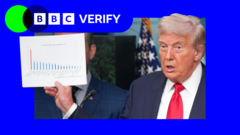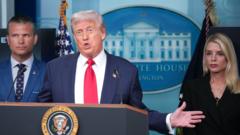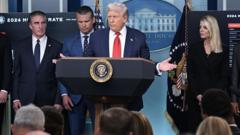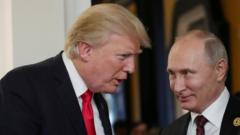While Trump's pressure intensifies, the Kremlin remains resilient, indicating that its military aspirations will not waver despite economic struggles.
Trump's Economic Strategy Faces Stubborn Russian Resolve Amid Ukraine Conflict

Trump's Economic Strategy Faces Stubborn Russian Resolve Amid Ukraine Conflict
Amid continuing tensions, President Trump threatens new economic measures as Russia proceeds with its military efforts in Ukraine.
In an effort to compel Russia to cease its ongoing invasion of Ukraine, President Trump has escalated his diplomatic and economic pressures on President Vladimir Putin. Recently, Trump announced plans for a meeting with Putin while simultaneously vowing to penalize India for purchasing Russian oil by imposing a hefty increase in U.S. tariffs.
Over the past several weeks, Trump has made it clear he intends to cripple Russia's economy if the Kremlin does not agree to a cease-fire, employing tactics such as imposing sanctions or blocking remaining markets for Russian oil. Nevertheless, the Kremlin has dismissed Trump's threats, demonstrating a commitment to advancing its military offensive.
The economic landscape in Russia is dire, with the nation's growth projected to be between 1 and 2 percent this year, a significant drop from the previous year's 4.7 percent growth rate. Economic analysts cite falling oil revenues and minimal growth in civilian sectors as troubling signs. High-interest rates continue to suppress private investments, leading to major companies placing workers on furlough.
Dmitri Gusev, a pro-government lawmaker, voiced concerns, stating that "the largest Russian companies are unable to invest in their development." In response to the economic downturn, the Kremlin’s seasoned economic team has successfully staved off a full-blown crisis. Some economic figures have even observed that the slowing growth has contributed to diminished inflation rates while encouraging cautious spending.
Despite the war's catastrophic toll, some studies indicate that average Russian living standards have reached their highest levels in a decade, thus providing the Kremlin with a buffer against potential unrest stemming from economic adversity.
However, the critical threat remains the plummeting oil revenue, down 18 percent this year due to declining global prices, pushing the Russian government to increase its anticipated budget deficit for the year. Analysts predict that the government will manage this deficit by tapping into its sovereign wealth fund, selling bonds to local banks, and trimming social expenditures—methods unlikely to hinder military spending, which currently constitutes about 8 percent of the country's GDP.
Trump's plan primarily aims to target Russian oil revenue, which sustains a substantial portion of Russia’s federal budget. He posited that lowering energy prices by just $10 per barrel could lead to a cessation of hostilities by Putin. Moreover, Trump's ultimatum for India, now the second largest purchaser of Russian oil, involves a notable 25 percent tariff, yet Indian officials have indicated their intent to continue sourcing Russian crude.
As India adapts to geopolitical risks, analysts suggest that Indian refiners are expecting larger discounts on Russian oil, mitigating the impact of potential tariffs. Despite forecasts that a $10 decrease in oil prices could amplify Russia's budget deficit, experts believe it would not pose an existential threat to the Kremlin’s ambition to continue its military operations.
Oleg Matsnev contributed reporting from Berlin, while Anatoly Kurmanaev offers insights on Russia’s ongoing transformations following the conflict in Ukraine.




















